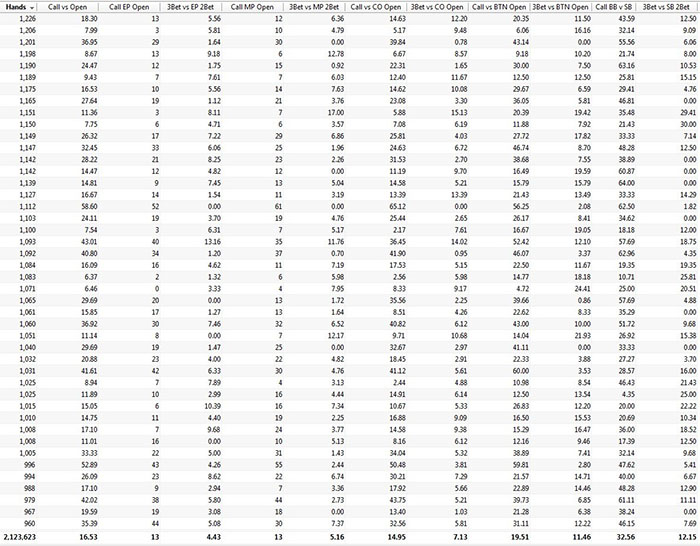Population tendency, as it is referred to in Economics,
is a technique used widely in situations  where target specific information is
not available. The main economic application is in advertising and marketing
but it also has uses in many branches of science and–yes, you guessed it–of
course poker.
where target specific information is
not available. The main economic application is in advertising and marketing
but it also has uses in many branches of science and–yes, you guessed it–of
course poker.
What population tendencies are able to describe can be
fascinating and useful if created accurately. They can give us insight into a
more exact way to perceive the unknown and in doing so, change our
understanding of what the unknown is. Creating population tendencies requires
two things: data as a source, and the means to effectively filter this data to
analyse its relevance to a goal. The volume of data necessary is dependent on
the analysis you are making. In poker we need samples in the millions to
accurately apply population tendencies to most statistics.
To achieve this application, we use what is referred to
as ‘big data’. This is exactly what it sounds like, vast quantities of related
information that tend to be stored and correlated through the use of a
database. Sound familiar yet? That's because most of you reading this already
have the facility to collect such data. It is of course the database that your
poker tracking software uses. You will see forum conversation where people
quote population reads as evidence to support a strategy argument. What you
never see is the justification for where they got them from. The truth is, it
is because they rarely have any beyond what they think. When Big Data is
involved in a problem, you most definitely do not want to trust are human
intuition or opinion.
In poker the term ‘population tendency’ has been
re-branded to Population Reads. These have several applications. The primary one allows us access to
information we need to analyse a situation where we face an unknown player and
therefore have no specific reads. Defining the type of read is important. A
specific read comes just from information gathered on one player. A true
population read, in the poker context, is the information gathered from all
players in that pool and then quantified in a way that allows us to assign a
definite frequency to any unknown players’ statistics which will in the long
run, be the most accurate method possible. The method most often used is
averaging and this is what we will work with in this series of articles.
We can use an underutilised tool in PokerTracker to find
population reads over significant samples. In the Reports feature of
PokerTracker, you will find that you can create reports that analyse results
for every player in your database. This function conveniently also
automatically averages all results for you.
To create a report to analyse population reads in
PokerTracker, follow these steps:
- In the PokerTracker “View Stats” tab, select the “My Reports” tab
- Select “New Report” from the left hand menu,
- When presented with 3 options for which kind of report you would like to create, select “All Players Report” which is the middle option.
- Add any stats you would like to see in the report from the “Available Stats” menu on the left-hand side. The defaults are Player, Hands and My Currency Won. If you would like to remove any of these just double click them.
When you have completed your report you will need to wait
while the database retrieves the data and does the necessary calculations. The
amount of time you will need to wait will depend on the sample size you are
working with and the speed of your storage device. Note that with large samples
this can take some time.
Below you can see a report that I have created which calculates the chances of each opponent calling each possible positional open raise and the associated positional chance that this open will be 3-bet. This report is based on a slightly over 2,000,000 hand sample of 100nl hands.

At the bottom of the report, the bold data shows us the
totals and averages (depending on the data type). You see how many players the
sample takes into account and over how many hands. It also defines the averages
for each positional stat we input.
What these statistics can tell us about the average 100nl
player is massive if we can analyse them correctly. We will take the far right
stats on the report of “Call BB vs SB” and “3 bet vs SB 2-bet” as our example
as it is the most simple. From the averaged data generated, we see that the
average player is going to call your SB steal attempt 32.56% of the time and 3
bet you 12.15% of the time. This makes a steal attempt unsuccessful on average
44.71% of the time and therefore successful 55.29% of the time.
First consider that mathematically if a steal attempt is
successful from SB 62.5% of the time or more then we can raise any two cards
and show a profit. It would seem that we have immediately found something of a
large edge in this 100nl player pool, after all we are only ~7% away from being
able to raise any hand and generate a profit.
So then what exactly can we raise when we have a success rate of only
55.29%? We can calculate this but that
is problem for a future article. What you should take from this today is an
understanding of the power that population reads have when calculated well and
consider how incorrect our own instincts can be when we estimate them.
Population reads can be used to increase our
profitability against unknowns, establish trends in how the game is evolving
and develop more optimal or exploitative strategies. In the coming articles we will go into much
more depth about how to apply specific population reads with a focus on
'in-game application' as well as studying the differences between the average
player at different stakes.


